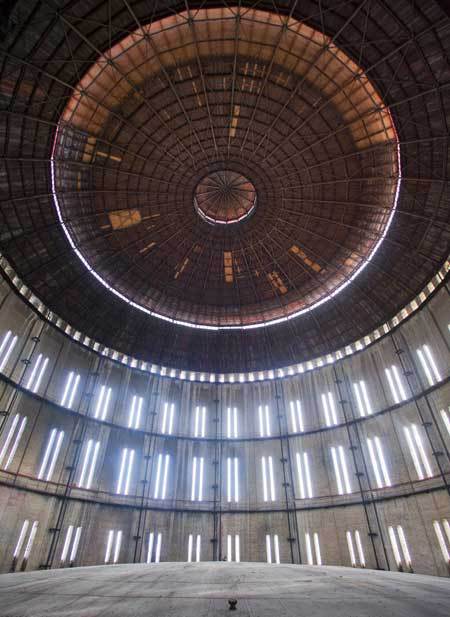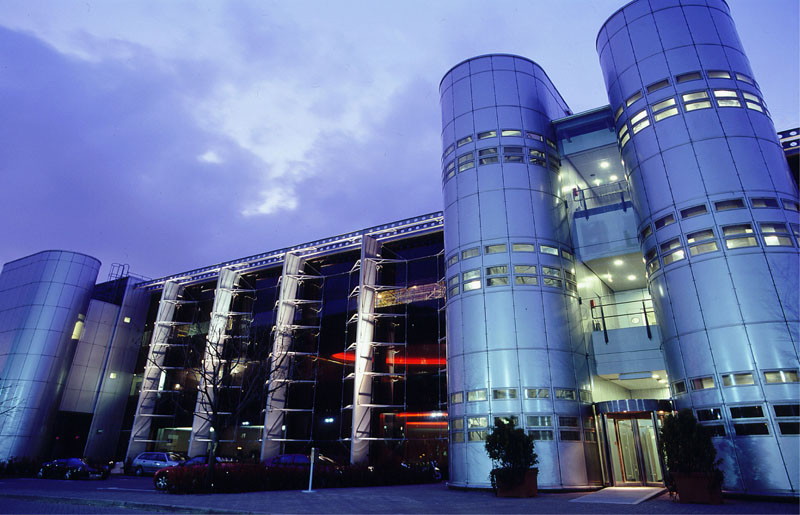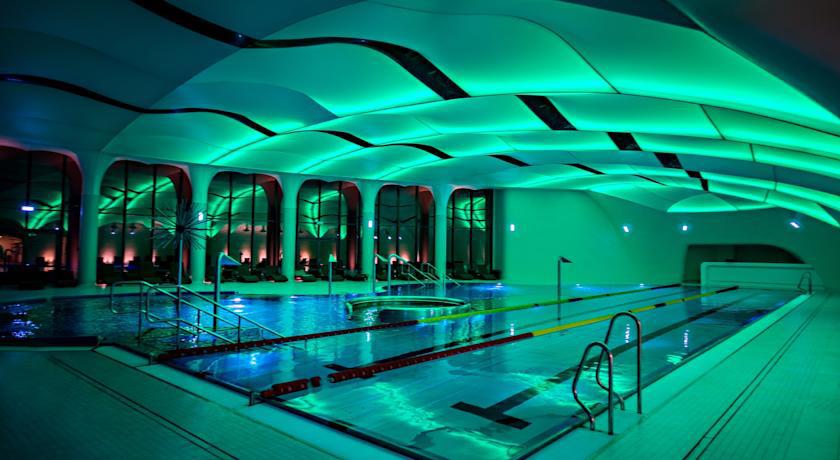Bahnhof data centers: servers, heating city buildings / mobile modular data center
The Swedish company Bahnhof is a master in creating projects of non-standard data centers. All their work combines frank aesthetics of forms, as if descended from the pages of science fiction. Design solutions of data centers seem to be torn out straight from films about the distant technological future. The result of their creative inspiration were DC James Bond Villain (Enemy of James Bond) and modular data centers, similar to space stations.
But non-standard design flight of imagination of employees is not limited. The development of one of the most ambitious projects of the company has gone in a new direction. As the executive director of Bahnhof, D. Karlung, announced this week, now we are searching for a site for a unique data center, which, in addition to its direct functions, will also be able to heat houses in downtown Stockholm.

')
The initial plan was to re-equip the former natural gas storage facility in Stockholm into a five-story data center. Built in 1893, the gasholder structure was built of red brick and crowned with a breathtaking cellular dome made of wood and iron, which, according to Bahnhof, gives a "sacred sense of space." But at the moment the project was postponed because of much more mundane considerations.

“To implement the project, unfortunately, it will take some time for politicians to approve all the necessary decisions,” said Karlung. - “We are now just postponing this project, focusing on other pressing tasks, but we will not abandon it”.
Due to the delay in the decision to allocate a gas storage facility for the planned project, the company is currently engaged in a dialogue with the city on the allocation of another site for DC. According to the new concept, the heat that is released during the operation of the DC will be transferred to the local heat supply company, which will be able to use it to heat the houses of citizens.
“This solution, which we are developing today at the site, is also located in the central region of Stockholm,” said D. Karlung. “The data center is a big radiator, and in a country with a cold climate, our solution makes sense. We will accumulate the allocated heat and sell it to the operator of the city’s heat network. ”
“From the point of view of business and economics, the proposed model — the return of expended energy through the accumulation and removal of heat — is effective, and this solution will necessarily be realized, albeit not at the moment based on a gas-holder,” said D. Karlung. “The proposed model is guaranteed to be profitable. Compensation due to the sale of heat for half of the funds spent on its generation will be a serious competitive advantage. In a city with cold winters in any case need heating. It’s just amazing that there are still no such solutions. ”
In fact, there are active discussions at this time, and there are several implementations of the idea of using an excess of the heat generated by the data center. A striking example of the use of this technology is TELUS in Vancouver, Canada, where the excess heat produced by the DC is sent to maintain the air conditioning system of the Telus Garden building.

In London, Telehouse began to use the excess heat produced by DC Docklands to heat nearby commercial and residential buildings as early as 2009.

IBM has its own DC in Switzerland, the excess heat from which is sent to heat the public pool.

Also, specialists from Microsoft and the University of Virginia developed an unusual concept published back in 2011. It was proposed to spread a huge cloud infrastructure to offices and homes, which would use the heat generated to support or even completely replace the existing heating system.
The main difficulty for the Bahnhof team according to the planned project is to find a site in a densely populated part of the city. “The reason why this technology has not yet been widely distributed is that the use of a central heating system is not particularly popular in many cities,” said D. Karlung. - “A densely populated area and a large heating plant are needed. Directly in Stockholm it is, but at the moment the heat is generated by burning coal. "
While the implementation of one project has been suspended, the modular data center “Lajka”, styled as a space station, has been successfully launched by the Bahnhof staff. “The modular project has been running for several weeks,” said D. Karlung. “This is a container solution, but it is not a container. This is a modular solution with a high degree of protection. ”

The structure of the building where the servers are located consists of a spacious modular room created from bullet-proof steel, connected to the “dome” - the central vestibule intended for the security service.
“At the moment we will use this DC for our own needs,” said D. Karlung. “But we have the drawings, and we are ready to sell this solution.” The product line has not yet reached the ideal, but with our help it is possible to bring it if you are interested in the project. I suppose that the solution might be of interest, for example, to the military. You can transport modules with trucks and install them very quickly in a new place. ”
The company is also known for the data center "James Bond Villain" - a high-tech server farm located in the bunker during the Cold War near Stockholm. Underground "den" is equipped with waterfalls, stylized as a greenhouse network control center, with a fully glass conference room, "floating" above the level of servers.

This object, like no other, reflects the belief of D. Karlung that DC should not just be cool, but also look cool! You can learn more about it from the publication: The most unusual Data Centers: Data Centers as art
But non-standard design flight of imagination of employees is not limited. The development of one of the most ambitious projects of the company has gone in a new direction. As the executive director of Bahnhof, D. Karlung, announced this week, now we are searching for a site for a unique data center, which, in addition to its direct functions, will also be able to heat houses in downtown Stockholm.

')
The initial plan was to re-equip the former natural gas storage facility in Stockholm into a five-story data center. Built in 1893, the gasholder structure was built of red brick and crowned with a breathtaking cellular dome made of wood and iron, which, according to Bahnhof, gives a "sacred sense of space." But at the moment the project was postponed because of much more mundane considerations.

“To implement the project, unfortunately, it will take some time for politicians to approve all the necessary decisions,” said Karlung. - “We are now just postponing this project, focusing on other pressing tasks, but we will not abandon it”.
Servers heating city buildings
Due to the delay in the decision to allocate a gas storage facility for the planned project, the company is currently engaged in a dialogue with the city on the allocation of another site for DC. According to the new concept, the heat that is released during the operation of the DC will be transferred to the local heat supply company, which will be able to use it to heat the houses of citizens.
“This solution, which we are developing today at the site, is also located in the central region of Stockholm,” said D. Karlung. “The data center is a big radiator, and in a country with a cold climate, our solution makes sense. We will accumulate the allocated heat and sell it to the operator of the city’s heat network. ”
“From the point of view of business and economics, the proposed model — the return of expended energy through the accumulation and removal of heat — is effective, and this solution will necessarily be realized, albeit not at the moment based on a gas-holder,” said D. Karlung. “The proposed model is guaranteed to be profitable. Compensation due to the sale of heat for half of the funds spent on its generation will be a serious competitive advantage. In a city with cold winters in any case need heating. It’s just amazing that there are still no such solutions. ”
Related projects
In fact, there are active discussions at this time, and there are several implementations of the idea of using an excess of the heat generated by the data center. A striking example of the use of this technology is TELUS in Vancouver, Canada, where the excess heat produced by the DC is sent to maintain the air conditioning system of the Telus Garden building.

In London, Telehouse began to use the excess heat produced by DC Docklands to heat nearby commercial and residential buildings as early as 2009.

IBM has its own DC in Switzerland, the excess heat from which is sent to heat the public pool.

Also, specialists from Microsoft and the University of Virginia developed an unusual concept published back in 2011. It was proposed to spread a huge cloud infrastructure to offices and homes, which would use the heat generated to support or even completely replace the existing heating system.
The main difficulty for the Bahnhof team according to the planned project is to find a site in a densely populated part of the city. “The reason why this technology has not yet been widely distributed is that the use of a central heating system is not particularly popular in many cities,” said D. Karlung. - “A densely populated area and a large heating plant are needed. Directly in Stockholm it is, but at the moment the heat is generated by burning coal. "
Modular project launched
While the implementation of one project has been suspended, the modular data center “Lajka”, styled as a space station, has been successfully launched by the Bahnhof staff. “The modular project has been running for several weeks,” said D. Karlung. “This is a container solution, but it is not a container. This is a modular solution with a high degree of protection. ”

The structure of the building where the servers are located consists of a spacious modular room created from bullet-proof steel, connected to the “dome” - the central vestibule intended for the security service.
“At the moment we will use this DC for our own needs,” said D. Karlung. “But we have the drawings, and we are ready to sell this solution.” The product line has not yet reached the ideal, but with our help it is possible to bring it if you are interested in the project. I suppose that the solution might be of interest, for example, to the military. You can transport modules with trucks and install them very quickly in a new place. ”
The company is also known for the data center "James Bond Villain" - a high-tech server farm located in the bunker during the Cold War near Stockholm. Underground "den" is equipped with waterfalls, stylized as a greenhouse network control center, with a fully glass conference room, "floating" above the level of servers.

This object, like no other, reflects the belief of D. Karlung that DC should not just be cool, but also look cool! You can learn more about it from the publication: The most unusual Data Centers: Data Centers as art
Source: https://habr.com/ru/post/220661/
All Articles